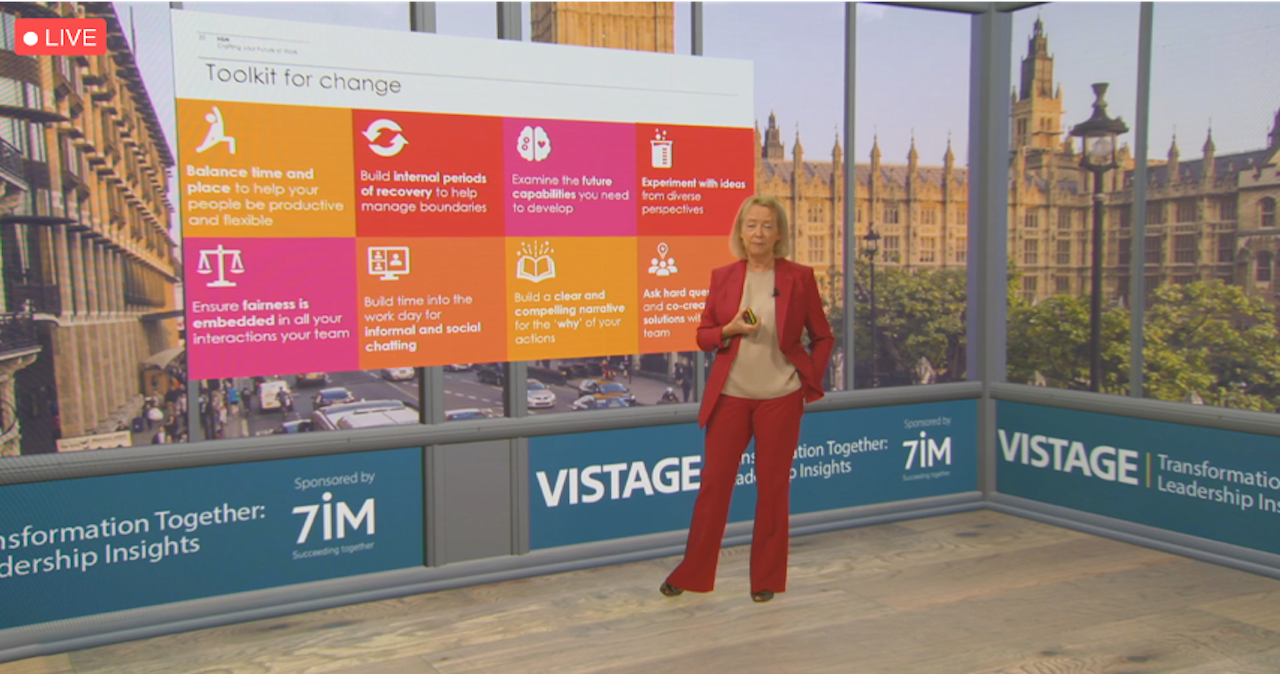What’s drained and fuelled you this year? Where next, and what’s next? I attended the Virtual Vistage Executive Summit last Friday that addressed these questions and provided leadership insights.
The keynote was run by Dr. Lynda Gratton, professor of Management Practice at London Business School and creator of The Future of Work Research Consortium. Prior to Covid, Dr. Gratton focused her research on the trends that were reshaping the world. These included:
- Tech – it’s changed and continues to change the pace of life.
- Demography – we’re going to live longer, and we’re going to be working into our 70s and 80s.
- Family / work dynamics – how the demands of balancing two lives impact working parents.
“In many ways, Covid has accelerated these trends and given us an opportunity to do a reset. We have a chance to reinvent work in a way we never have before,” said Gratton.
Leadership during the pandemic
Businesses have to respond to various challenges. At the beginning of this pandemic, there was a sense of unity across the nation. Working from home was a new thing and many felt excited and energised about a new way of contributing to business success that didn’t require a lengthy and uncomfortable commute.
But that energy is now dwindling. The initial burst of excitement has been replaced with something a little darker. Since we’re not able to get out and about and meet new people, our social networks are beginning to constrict. Every day feels the same as the day before, because there’s not much to break up the weeks, the months. And all this is taking a toll on our mental health, not to mention our performance at work. And for a leadership summit, that was of course the focus.
Maintaining productivity
Gratton believes that there are four aspects of productivity:
- ENERGY
- FOCUS
- COORDINATION
- COOPERATION
The trick to ensuring teams are happy, healthy and productive lies in understanding how the concept of PLACE and TIME can be reshaped to suit business needs. What does the workplace offer that the home does not? And vice versa? What are the benefits of working to a fixed time schedule, the standard 9-5, over an anytime, flexitime, asynchronous model?
It depends on which of the four aspects of productivity you’re looking to drive. If, for example, it’s all about FOCUS, then most would assume a flexible time model works better than a synchronous one. People have varying levels of effectiveness depending on the time of day. I’m a night owl. I do my best work after lunch. But my colleagues are early birds. What works for one doesn’t work for another so let people choose their own time to focus. If it’s all about COORDINATION, on the other hand, then a fixed time model is more likely to support the coming together of a group of people who are working towards the same goal.
But there is no quick fix to determine the where – office or home. Let’s look at FOCUS again. Some may work better at home, particularly if they’re able to work solo or undisturbed. Then again, there will be those who need an office to escape away from the hubbub of home life. Not everybody has a home office. Some may be sharing a crowded space with flatmates or family.
Working together in balance
When aiming to facilitate COOPERATION, we need to ask ourselves – what does it take to be innovative and creative? Well, that’s more about place not time. The office can be that central place for collaboration. Others would argue you can collaborate just as well via Zoom or MS Teams.
In fact, I would say that’s been the case for Magenta. We’re a creative agency that’s had to work from home for eight months. That hasn’t made us less effective. It hasn’t halted the production of ideas. If it had, we’d be in trouble! If anything, we’re more proactive, creative and socially cohesive than we were before Boris freaked the nation out in March. Indeed, we have responded to the need for communications support from so many businesses by creating a series of free communication guides.
Despite maintaining our productivity and creativity, the experience isn’t the same. And work isn’t just about being effective. Or performing. Or producing. It’s about having fun. It’s about enriching the working lives of those you work with and for. And, in my opinion, that magic can only really happen when there’s not a screen dividing you.
And so it’s important not to make assumptions about the best TIME and PLACE model – there’s not a one size fits all approach – but it is important to consider the aspects of productivity when coming up with a future work plan. In the process we have to be prepared to make a few ‘productivity trade offs’ before we can settle into a new routine.
Toolkit for change
To conclude, here’s Dr. Gratton’s TOOLKIT FOR CHANGE:
- Balance time and place to help your people be productive and flexible
- Build internal periods of recovery to help manage boundaries
- Examine the future capabilities you need to develop
- Experiment with ideas from diverse perspectives
- Ensure fairness is embedded in all your interactions with your team
- Build time into the workday for informal and social chatting
- Build a clear and compelling narrative for the ‘why’ of your actions
- Ask hard questions and co-create solutions with your team
To see more virtual events from Vistage and to find out how the executive coaching organisation can provide leadership insights that help you you enhance your leadership skills, visit the Vistage website.








